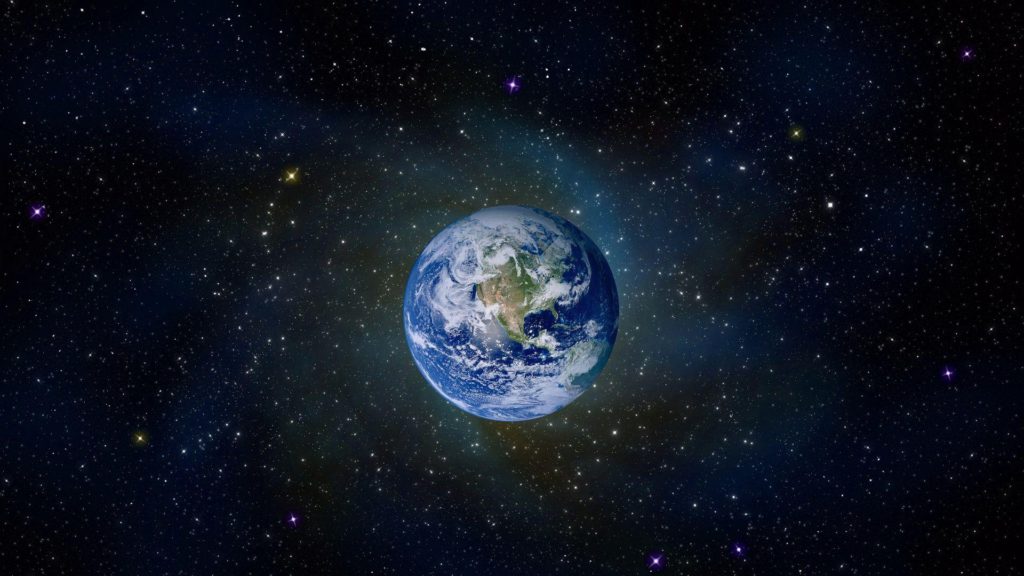- Why is Water necessary for life?
- Water Supports Cellular Structure
- Water also plays a role in the creation of the membranes that surround cells. Every cell on Earth is encased in a membrane, the majority of which is made up of two layers of phospholipid molecules (Figure 3).
- Proteins in the cell provide it structure, receive signals, and catalyse chemical reactions.Proteins are the workhorses of cells in this sense. They are ultimately responsible for muscular contraction, communication, nutrient digestion, and a variety of other critical processes.If proteins lacked the proper structure, they would be unable to perform these jobs, and a cell (let alone a whole person) would perish.
- Chemical Reactions Of Water
- Scarcity of Water
- Water and Climate change
- Water Conservation
- Rainwater Harvesting
- Advantages
- The Apatani’s System
- Conclusion
- FAQS
Why is Water necessary for life?
Water is required for survival and an essential element for life. Domestic, agricultural, and industrial uses all necessitate the use of water.
Water bodies cover three-quarters of the Earth’s surface. The oceans contain 97 percent of this water, which is unsafe for human consumption. Fresh water accounts for only about 2.7 percent of the total. Nearly 70% of this is found in Antarctica and other inaccessible locations as ice sheets and glaciers. Only 1% of fresh water is suitable for human use. As a result, safeguarding this unique resource is critical. Despite this, sewage, harmful chemicals, and other wastes are poisoning existing water resources.

Water makes about 60-75 percent of a person’s weight. Dehydration can occur with a loss of merely 4% of total body water, and a loss of 15% can be fatal. A human, on the other hand, can go a month without eating but not three days without drinking. This critical dependency on water governs all life forms. Water is plainly necessary for survival, but why is it so critical?
Water’s Molecular Structure
Water’s molecular structure and a few unique features are responsible for many of its functions in supporting life. Water is made up of two small, positively charged hydrogen atoms and one massive negatively charged oxygen atom. When hydrogens bind to oxygen, an asymmetrical molecule is formed with a positive charge on one side and a negative charge on the other (Figure 1). Polarity is the charge differential that governs how water interacts with other molecules. Polarity is the charge differential that governs how water interacts with other molecules.

Water is the “Universal Solvent”
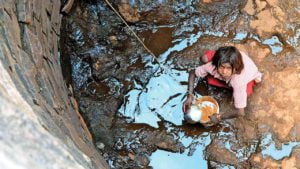
Water interacts best with other polar molecules, such as itself, because it is a polar molecule. This is due to the phenomena of opposite charges attracting one another: each water molecule has both a negative and positive part, therefore each side is attracted to molecules of the opposite charge. Because of this attraction, water may form strong connections with other polar molecules in its environment, including other water molecules.
In this situation, one water molecule’s positive hydrogen will link with the negative oxygen of the next molecule, whose hydrogens will be drawn to the next oxygen, and so on (Figure 1).
The importance of this bonding is that it helps water molecules to cling together, a property known as cohesion. Water molecules’ cohesiveness aids plants in absorbing water at their roots. Water’s high boiling point is due to cohesion, which helps animals control their body temperature.
Water molecules can also create connections with and surround both their positive and negative sections, making them polar, because most biological molecules have some electrical asymmetry.
Water wriggles its way into all the nooks and crannies between molecules as it surrounds the polar molecules of another substance, effectively breaking it apart and dissolving it. Because both water and sugar are polar, when you put sugar crystals in water, individual water molecules can surround individual sugar molecules, breaking them apart and dissolving the sugar.
Moreover, some molecules are made up of ions, which are oppositely charged particles with polarity. Water interacts with both positively and negatively charged particles to break up these ionic compounds. Because salt is made up of sodium and chloride ions, this is what happens when you add salt to water.
Water Supports Cellular Structure
In biology, water plays a crucial structural role. Water optically fills cells, assisting them in maintaining their form and structure (Figure 2).
The water inside many cells (including those that make up the human body) creates pressure that opposes external forces, similar to putting air in a balloon. Plants that can maintain their cell structure without water, on the other hand, require water to survive. Water allows everything inside cells to have the right structure at the molecular level. Furthermore, one of water’s most significant functions is to maintain form, which is essential for metabolic activities.
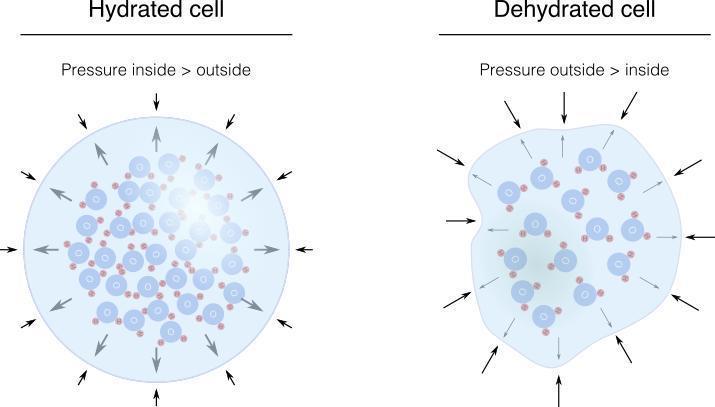
Water also plays a role in the creation of the membranes that surround cells. Every cell on Earth is encased in a membrane, the majority of which is made up of two layers of phospholipid molecules (Figure 3).
Like water, phospholipids have two separate parts: a polar “head” and a nonpolar “tail.” The polar heads engage with water as a result of this, whilst the nonpolar tails try to avoid water and instead interact with one other. Phospholipids naturally form bilayers with the heads facing outward towards the surrounding water and the tails facing inward, excluding water, in search of these beneficial interactions. The bilayer surrounds cells and allows ions and nutrients to enter and exit the cell selectively. The connections that make the membrane are strong enough that it forms spontaneously and is difficult to destroy. Cell membranes would lack shape without water, and cells would be unable to retain vital molecules inside the cell and dangerous molecules outside the cell without adequate membrane structure.
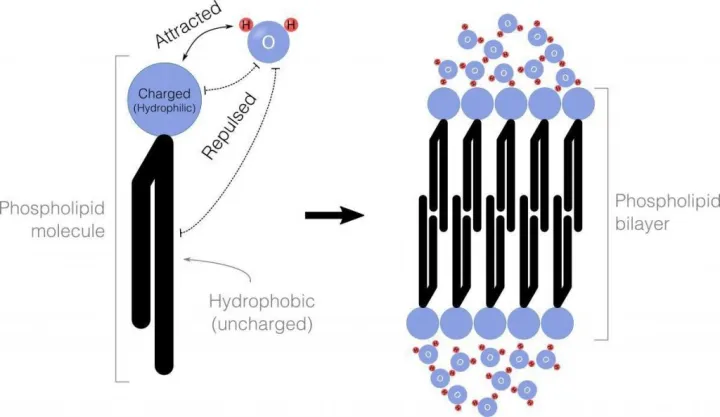
Water affects some fundamental components of every cell, including DNA and proteins, in addition to their overall form. Proteins are made up of a long chain of amino acids that must fold into a precise form in order to function properly. As different types of amino acids seek and avoid interaction with water, water causes the folding of amino acid chains.
Proteins in the cell provide it structure, receive signals, and catalyse chemical reactions.Proteins are the workhorses of cells in this sense. They are ultimately responsible for muscular contraction, communication, nutrient digestion, and a variety of other critical processes.If proteins lacked the proper structure, they would be unable to perform these jobs, and a cell (let alone a whole person) would perish.
DNA, too, requires a certain form in order for its instructions to correctly decipher. Only a specific shape of DNA bind by proteins that read or copy DNA. To support DNA’s unique double-helix structure, water molecules surround it in an orderly method. Without this form, cells would be unable to obey DNA’s detailed instructions or pass them on to subsequent cells, rendering human growth, reproduction, and, eventually, survival impossible.
Chemical Reactions Of Water
Water is directly engaged in the synthesis and breakdown of important cell components in a number of chemical reactions. Photosynthesis, the process in which plants produce sugars for all living things, necessitates the presence of water. It also aids in the formation of bigger molecules in cells. For example, DNA and proteins are made up of repeating units of smaller molecules. It is produced as a result of the reaction that brings these tiny molecules together. Water, on the other hand, is essential for the reaction that breaks down these molecules, allowing cells to absorb nutrients or recycle fragments of larger molecules.
Water also protects cells from the harmful effects of acids and bases. Even the toughest materials are corroded by highly acidic or basic chemicals like bleach or hydrochloric acid. This is due to the fact that acids and bases, respectively, release or take up extra hydrogens from the surrounding materials. The structure of molecules is disrupted when positively charged hydrogens are lost or gained.
Proteins, as we’ve seen, require a precise structure to function properly, therefore protecting them from acids and bases is critical. Water does this by simultaneously acting as an acid and a basic (Figure 4). A water molecule can lose hydrogen and become OH–, acting as a base, or gain another hydrogen and become H3O+, acting as an acid, despite the chemical bonds inside it being extremely stable. Additionally, In a process known as buffering, water’s versatility allows it to fight extreme pH shifts caused by acidic or basic chemicals in the body. In the end, this protects the cell’s proteins and other components.

Finally, water is essential for all living things. Its adaptability and plasticity aid in the execution of critical chemical reactions. Its basic molecular structure aids in the preservation of key forms for the interior components of cells and the outside membrane. When it comes to special qualities that support life, no other molecule compares to water. Researchers are discovering new properties of water, such as extra impacts of its asymmetrical structure, which is exciting. The physiological effects of these qualities have yet to discover by scientists. It’s incredible how a single molecule can be so crucial to organisms with such varied needs.
Scarcity of Water
Water contamination and shortages have resulted from the overuse of water resources as a result of expanding population and rapid urbanization. A condition in which people do not have enough water to meet their fundamental needs is known as water shortage. India is one of the countries that is now suffering from a lack of water. Despite being the world’s second-most populous country, India is the world’s largest freshwater consumer, with groundwater accounting for 39% of total consumption.
Women in Rajasthan and portions of Gujarat must travel great distances on foot to obtain a pot of water. A family’s daily water needs in Bangalore range between Rs. 15 and Rs. 20. The problem grows more serious during the summer months when water availability decreases again.
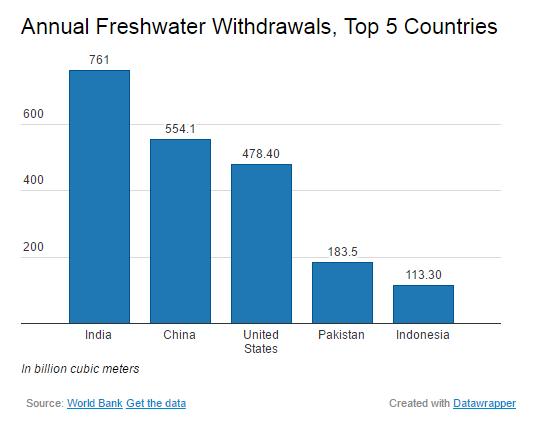
How safe is our water?
According to a recent poll, roughly a quarter of the population of the metropolitan area does not have access to safe drinking water. The qualities of water in India are changing due to increased demand and development pressure. Groundwater is becoming increasingly depleted and scarce, while surface water is becoming increasingly polluted and unfit for human consumption. Water quality is critical for both human health and the ecosystem. However, ensuring that everyone has access to enough healthy water is a major concern right now. India’s surface water resources are dirty to the tune of 70%. There have also been several instances of water bodies being privatized. Moreover, this results in water scarcity in the districts. It is the need of the hour to focus on saving water and making policies that will help conserve existing water resources.

Water and Climate change
- The principal manifestations of climate change are changes in the water cycle.Droughts, floods, melting glaciers, sea-level rise, and storms all worsen or change as the climate changes, often with disastrous results.
- The effects of climate change have immediate implications for water security and conflict.
- Climatic change adaptation will have to improve climate resilience in order to meet the Sustainable Development Goals.
- Healthy ecosystem services rely on well-functioning river basins to increase climate resilience.
- Climate change is effective. The importance of water management in decreasing vulnerability and creating climate resilience .
The-Effect-of-Climate-Change-on-water-Resources-and-Programs – Download
Water Conservation
Water conservation has an obvious impact on a sustainable environment, especially as the world grapples with the growing urgency of addressing climate change. For the country’s ever-growing household, agricultural, and industrial sectors, groundwater is the primary supply of freshwater. The necessity to utilize groundwater resources for a variety of everyday functions, including toileting, bathing, cleaning, agriculture, drinking water, industry, and ever-changing lifestyles with modernity, has been recognized over time, resulting in massive water waste.
Despite the fact that various technical gadgets are being created to reduce water waste, the impact will be larger if each individual contributes to water conservation by minimizing or optimizing groundwater usage for daily activities.

Every year, we notice the depletion of water resources. Furthermore, humans are unable to create artificial water and must rely on water sources found on our planet. As a result of population increase and an ever-increasing demand for water to maintain our ever-expanding contemporary lifestyle and we notice the shortage of water and depletion of groundwater level. Also, this has prompted major water conservation concerns.
In this way, collection of rainwater and groundwater recharge are two of the simplest and most effective ways to conserve water globally. Additionally, this approach can be used in place of traditional water supplies that are nearing the end of their useful life.
Rainwater Harvesting
It is a basic approach for collecting and storing rainwater for later use. Rainwater is collected and stored in man-made or natural catchment areas such as rooftops, compounds, rocky surfaces, hill slopes, or artificially repaired impervious/semi-pervious land surfaces in artificially formed systems. Furthermore, after collecting from surfaces where rain falls, the process for filtration and storage takes place in a variety of ways, or directly get from the recharge . Rainwater harvesting is unfettered by impurities, has a lower storage cost, and requires little maintenance other than periodic cleaning. Moreover, with diminishing groundwater levels and changing climate conditions, this approach can go a long way toward reducing the negative consequences of rising water scarcity.
Advantages
Reduced Water Bills
Rainwater collecting systems are affordable, produce high-quality water, reduce reliance on wells, and are very simple to maintain because they have no other users like for drinking, cooking, or other sensitive purposes. Moreover, the overall expenses of setting up harvesting technologies are significantly lower than other purifying or pumping operations.
Ecological benefit
It is environmentally friendly to store water underground. Rainwater harvesting has numerous environmental advantages. Furthermore, It helps to alleviate the pressure on drainage systems by funneling the runoff into enormous tanks for recycling, reducing the impact of flooding Groundwater, not immediately exposed to evaporation and contamination because There was no land for storage purposes and no population displacement. It also helps to reduce the likelihood of rivers drying up. To conclude Save the BLUE, so you don’t go blue. Save water.
Reduces erosion and flooding around buildings
It prevents urban flooding by lowering soil erosion and flood dangers by collecting rainwater and regulating stormwater flow. Most rainwater harvesting buildings feature a built-in collection space on top of the roof that can store considerable amounts of water during heavy rains.
An adequate means for Irrigation purpose
Rainwater harvesting allows vast amounts of water collection and also minimizes drought effects. The majority of rooftops provide the essential collection platform. Rainwater is suitable for irrigation since it is normally free of harmful contaminants.
Reduces demand on Ground Water
It also increases aquifer productivity, which improves groundwater levels and reduces the requirement for potable water. It’s crucial, especially in areas with low water levels.
There are two techniques of rainwater harvesting
1. Surface runoff harvesting
Surface runoff collects rainwater and stores it for later use. Furthermore, surface water can be stored by diverting the flow of minor creeks and streams into surface or underground reservoirs. As a matter of fact, It can make available water for agriculture, animals, and ordinary household use. In metropolitan settings, surface runoff collection is the best option.
Following methods help in collecting stormwater/rainwater in metropolitan locations.
Recharge Pit, Recharge Trench, and the Recharge Well
2. Groundwater recharge
Water travels downward from surface water to groundwater in a hydrologic. The process is known as groundwater recharge. Recharge is the most common way for water to enter an aquifer. Also, the aquifer also functions as a system of distribution. Using artificial recharge techniques and the excess rainwater to recharge the groundwater aquifer.
Following methods help in collecting rainwater in rural areas:
• Gully Plug, Bund Contour, Recharge at Dugwell, Tank for percolation, Examine the dam, the cement plug, Nala Bund and The Shaft Recharge
| Urban Areas | Rural Areas |
| Roof Top Rain Water / runoff harvesting through: 1. Recharge Pit 2. Recharge Trench 3. Tubewell 4. Recharge Well | Rain Water Harvesting through: 1. Gully Plug 2. Contour Bund 3. Gabion Structure 4. Percolation tank 5.Check Dam/ Cement Plug/ Nala Bund 6. Recharge shaft 7.Tugwell Recharge 8. Ground Water Dams/Subsurface Dyke |
Despite the fact that rainwater collecting is a desirable notion in recent years, Rural India does not use it. Moreover, rainwater harvesting and artificial recharge technologies are famous in various parts of the country. Madaras, Ahar Pynes, Surangas, and Thanks are some of the traditional rainwater gathering technologies used in India.

Some Examples of Traditional water harvesting system in India
Trans-Himalayan Region
Zing -Tanks for collecting water from melted ice in Ladakh.
Western Himalayas
Kul -Water channels in mountain areas of Jammu, Himachal Pradesh.
Naula -Small ponds in Uttaranchal.
Eastern Himalayas
Northeastern Hill Ranges
Apatani system -Terraced plots connected by inlet and outlet channels in Arunachal Pradesh.
Zabo -Impounding runoff in Nagaland
Bamboo drip irrigation – Water from streams in the hills connects to the plains via bamboo pipes for drip irrigation in Meghalaya
Brahmaputra Valley
Dongs – Ponds in Assam
Dungs or Jampois – small irrigation channels linking rice fields to streams in the Jalpaiguri district of West Bengal
Indo-Gangetic Plain
Dighis -Small square or circular reservoir fed by canals from rivers in Delhi
Baolis – secular structured stepwells from which everyone could draw water and use for washing and bathing.
Thar Desert
Boris / Bers -Community wells in Rajasthan
Tankas -Underground tank Bikaner in Rajasthan
Kund – a circular underground well; having a saucer-shaped catchment area that gently slopes towards the center where the well exists.
Central Highlands
Johads -Earthen check dams in Alwar district, Rajasthan
Rainwater Harvesting In Arunachal
During the 11th Five Year Plan, the Arunachal Pradesh water resources department completed 235 demonstration projects on rooftop rainwater harvesting and artificial groundwater recharge under the 100 percent central sector scheme “Groundwater management and regulation,” which covered 235 projects in 11 districts. Tawang, West and East Kameng, Papum Pare, Kurung Kumey, Lower and Upper Subansiri, East and West Siang, Lower Dibang Valley, Anjaw, Miao (Changlang), Tirap, and Longding were the effected districts . As a result of the above inspection carried out in 100 projects in government schools, hospitals, primary health facilities, office buildings, and Circuit houses. Furthermore, these projects are complete and handed over to the user agencies for operation, maintenance, and use for a variety of water needs.
The Apatani’s System
a wet rice and fish farming technology used in higher elevations of roughly 1600 meters and gently sloping valleys. For irrigation, this system collects both ground and surface water. The Apatani tribes of Ziro in Arunachal Pradesh’s Lower Subansiri district follow this. 0.6 meter high earthen dams, frames of bamboo tree that Apatani techniques support. The intake and outlet are on opposing sides of each plot. The low-lying plot’s inlet also serves as an outflow for the high lying plot. The intake and output points are by deeper channels.
Additionally, water can be inundated or drained from the terraced plot by opening and closing the inlets and outlets as needed. Furthermore, the Construction of a 2-4 m high and 1 m thick wall near forested hill slopes taps stream water to further save water. A canal network transports this to agricultural fields.
Conclusion
Rainwater collecting and collection is a viable solution to the global problem of water scarcity. Every community benefits greatly from the adoption of a rainwater harvesting system. This simple water-saving method can be a boost to an excellent solution in areas where there is ample rainfall but insufficient groundwater resources. Moreover, It will not only give the most sustainable and effective water management solution, but it will also open up a plethora of new economic prospects, resulting in grassroots empowerment.
To make it a real success, the government needs to come up with an appropriate incentive structure and logistical support. Rather than resting hopes on the administration to solve the water situation, thousands of people around the world should join in rainwater gatherings.
There are various ways to resolve the problem of water scarcity.
Collecting rainwater is the most appropriate method. It not only minimizes Surface runoff but also recharges groundwater through the forest and another vegetation cover. As a result, practice afforestation. The role of media and public awareness campaigns is very crucial for water conservation and saving water. Moreover, methods of water conservation are a simple and practical approach with several advantages that may be easily implemented in individual homes, flats, parks, and throughout the world. Charity, as we all know, begins at home, and a commitment to society’s well-being must also begin at home. As we all know, charity begins at home, and a dedication to society’s well-being must begin there as well.
FAQS
Q.1 What is save water save life?
By practicing these simple steps we can conserve water and ensure the availability of water to future generations. So don’t tarry; start saving each and every drop of water. Additionally, Let our motto be “Save water, save a life, save the world”.
Q.2 Why should save water?
Conserving water is important because it keeps water pure and clean while protecting the environment. … Only 2% of the Earth’s fresh supply of water is in ice caps and glaciers, while 97,5% of the earth’s water is saltwater. Furthermore, Conserving water involves refraining from water pollution. So It become so essential to save water ( Save water. Save Earth).
Q.3 Why we say water is life?
Water is one of the most precious resources which we have on earth. … require water to function. Moreover, It is essential for the existence of life on earth as it is an essential component of all biological processes. As a matter of fact, we cannot imagine our lives without the presence of water. So saving water should become our routine. Also, we have a saying “Save water, and it will save you”.
Q.4 what are 5 benefits of water?
Top 5 Benefits of Drinking Water
- Increases Energy & Relieves Fatigue. Since your brain is mostly water, drinking it helps you think, focus and concentrate better and be more alert. …
- Promotes Weight Loss. …
- Flushes Out Toxins. …
- Improves Skin Complexion. …
- Maintains Regularity. So it become very important to save water.
Q.5 What are 5 ways to save water?
- Check your toilet for leaks to save water
- Stop using your toilet as an ashtray or wastebasket. …
- Put a plastic bottle in your toilet tank. …
- Take shorter showers this will help in saving water
- Install water-saving shower heads or flow restrictors.
Q.6 How can we save water in the kitchen?
There are some ways that can help save water in the kitchen.
- Go for the full load. Hold off on running the dishwasher until you have a full load of dishes. …
- Steam whenever possible as it will help in saving water.
- Reuse cooking water can make huge impact and save a lot of water.
- Soak stubborn pots. …
- Avoid rinsing dirty dishes. …
- Dry brush and spot clean floors . This will truly save water.
Share with your friends




